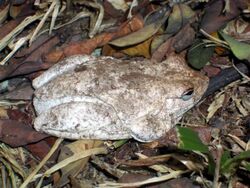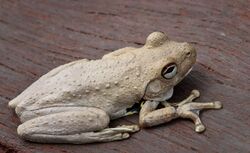Biology:Roth's tree frog
| Roth's tree frog | |
|---|---|

| |
| Scientific classification | |
| Domain: | Eukaryota |
| Kingdom: | Animalia |
| Phylum: | Chordata |
| Class: | Amphibia |
| Order: | Anura |
| Family: | Hylidae |
| Genus: | Litoria |
| Species: | L. rothii
|
| Binomial name | |
| Litoria rothii (De Vis, 1884)
| |
| Synonyms | |
|
Hyla rothii De Vis, 1884 | |
Roth's tree frog (Litoria rothii), or the northern laughing tree frog, is a species of tree frog native to northern Australia and southern Papua New Guinea.[1][2] Roth's tree frog is a common frog, closely related to Peron's tree frog (Litoria peronii) and Tyler's tree frog (Litoria tyleri).
Description
Roth's tree frog is a medium-sized frog, reaching a maximum length of 5.7 cm (2.2 in). The body is elongated, with a small head and large eyes. It is an arboreal frog, and its toe pads are wider than its fingers. The dorsal surface is a dull grey to brown colour, and can be blotched with dark brown. The inner thighs and armpits are black and blotched with bright yellow or orange. The tympanum is visible, with a fold of skin covering the top portion.
There are two features that distinguish it from both Peron's tree frog and Tyler's tree frog - the upper half of the iris is deep red, and it has no emerald green flecks on the dorsal surface.
Ecology and behaviour
Roth's tree frog breeds during the wet season, from November to March. The call is seven to 9 loud, chuckling or cackling sounds that resemble laughter. Eggs are laid in temporary pools of water, and the tadpoles take a maximum of 65 days to metamorphose.
The colour of Roth's tree frog is extremely variable, and can change from pale grey to dark brown within hours. Typically, they are grey during the day whilst basking in the sun, and are brown at night.
References
- ↑ 1.0 1.1 Jean-Marc Hero, Dale Roberts, Paul Horner, Richard Retallick, Stephen Richards, Fred Parker (2004). "Litoria rothii". IUCN Red List of Threatened Species 2004: e.T41109A10400013. doi:10.2305/IUCN.UK.2004.RLTS.T41109A10400013.en. https://www.iucnredlist.org/species/41109/10400013. Retrieved 19 November 2021.
- ↑ Frost, Darrel R. (2015). "Litoria rothii (De Vis, 1884)". Amphibian Species of the World: an Online Reference. Version 6.0. American Museum of Natural History. http://research.amnh.org/vz/herpetology/amphibia/Amphibia/Anura/Hylidae/Pelodryadinae/Litoria/Litoria-rothii. Retrieved 15 September 2015.
- Barker, J.; Grigg, G.C.; Tyler, M.J. (1995). A Field Guide to Australian Frogs. Surrey Beatty & Sons. ISBN 0-949324-61-2.
- Tyler, Michael J. 1992. Encyclopedia of Australian Animals: Frogs. Angus & Robertson. ISBN:0-207-15996-3
- "Frogs Australia Network - Australian Frog Database - Litoria rothii - Northern Laughing Treefrog". Archived from the original on August 24, 2006. https://web.archive.org/web/20060824113119/http://www.frogsaustralia.net.au/frogs/display.cfm?frog_id=183. Retrieved 2006-08-27.
Wikidata ☰ Q2276410 entry
 |





